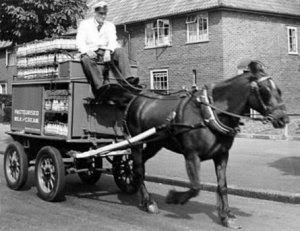 |
| Eating Watermelon |
The Wieser Years (continued)
None of the streets in town were
hard surfaced in those days. In
order to keep the dust down, every day a sprinkler wagon would come around to
wet down the streets. We would get
on our swimsuits and await the arrival of the sprinkler truck. When it came we would go run behind it
as far as we could getting a free shower bath.
 |
| Bathing suit |
Another interesting and cooling summer time treat was to
jump on the back step of the “Ice Wagon” and scoop up chunks of chipped ice
while the ice man was gone into a house delivering a big twenty-five to fifty
pound block of ice to put into the ice refrigerator. There were no electric refrigerators in those days.
 |
| Little Willie |
The
younger generation may be interested in how the ice deliverymen operated. In some communities where there was no
ice plant where ice was manufactured, ice blocks were sawed from frozen lakes
or rivers and stored in insulated icehouses for use the next summer. I think Wieser had an ice plant where
big blocks of ice about four feet long, two and three feet wide and about on foot think were frozen from pure water.
The “ice man” would load his ice wagon, which was a horse drawn vehicle
with solid sides and a roof over the top. Only the back end was open.
 |
| Ice man 1920s |
There was a step on the back where the iceman stood to chip off with an
ice pick a smaller block from the big block of ice. Then there was always a spring scales attached to the back
of the wagon where the chunk of ice hanging from the ice tongs could be
weighed. The ice man always had a
heavy leather shoulder protector that was draped over their shoulders and hung
down in the front and back to below the waist to serve as padding and keep the
wet ice from soaking through their clothing. The ice customer who needed ice would hang a sign in their
window showing the number of pounds of ice they wanted.
 |
| Pratt Ice wagon |
The ice man who soon became skillful in
knowing the right size chunk to make certain weight would split a piece off
with his ice pick. Grab it with
the ice tongs, hang it on the scales, and then throw the piece of ice onto his
shoulders and trot into the house where he would place the piece of ice in the
“ice box”, as they were commonly called.
Another
thing I enjoyed doing in the summer time was to ride around the milk route on
the horse drawn milk wagon with our milkman. When he arrived at our house, I would run out to meet
him. He would usually invite me to
climb aboard. After a few trips
around the route he would let me run into the houses with the milk
bottles. This gave him a needed
rest, and made me feel real important.
An amazing thing about the milk route was that the horse knew where to
stop without being told.
 |
| Horse drawn milk wagon 1920s |
Another
deliveryman that I used to ride with was a future relative of ours, Willard
Ibey. He drove a little two-wheel
meat delivery cart, which was also horse drawn. This cart was built something like a chariot, with a
platform in the back to stand on.
In the front of the platform and between the two large wheels was a box
with a hinged lid where the packaged meat was stored for delivery to the
customers who had ordered it from the meat market.
No comments:
Post a Comment